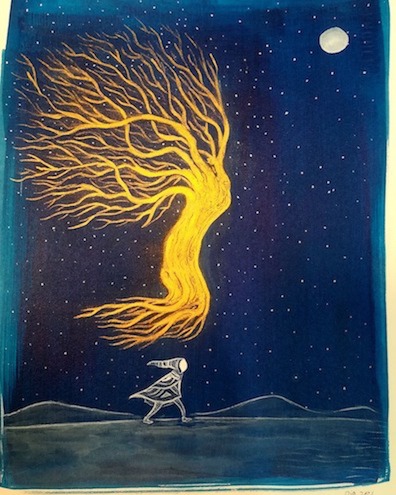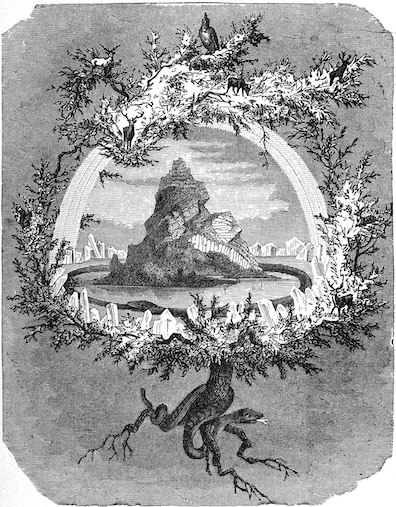All three cantiche of the Divine Comedy
conclude with the word stelle, "stars." In canto 34 of
the Inferno Dante and Virgil end their dark tour of
Hell, passing by Satan at the bottom of the ninth circle and
climbing up a narrow channel "to find again the world of
light" (134). They get "far enough to see, through a round
opening, / a few of those fair things the heavens bear. /
Then we came forth, to see again the stars" (137-39).
Joyce echoes these lines twice. In addition to the full vision
of the night sky evoked in "The heaventree of stars," he
recalls the tiny round opening of lines 137-38 by suggesting
that the Milky Way would be "discernible by daylight by
an observer placed at the lower end of a cylindrical
vertical shaft 5000 ft deep sunk from the surface towards
the centre of the earth." Readers of the Inferno
will recall that "the centre of the earth," where Satan is
embedded in the ice, is where Dante's ascent to the light
begins.
In Dante's poem the heavenly bodies are omnipresent
companions. The passage of day and night and the cycling of
the seasons are known by the relative positions of the sun,
planets, and stars. Both Virgil and Dante display exacting and
comprehensive knowledge of medieval astronomy, and the poet
supplements scientific understanding with pervasive poetic
symbolism. (To cite one of many examples, the four stars that
he sees in canto 1 of Purgatorio are not only a
constellation, probably the Southern Cross, but also emblems
of the four cardinal virtues possessed by Adam and Eve.) Even
Dante's science is fanciful. Astronomy was inseparable from
astrology in medieval thinking, because causative divine
"influences" were thought to descend from the mind of God,
through particular constellations of stars and then through
the spheres of individual planets, to shape events on earth
and mold the dispositions of human beings.
In addition to their functions in time-keeping, moral
allegory, and etiology, Dante's heavenly bodies constitute a
vast mechanical apparatus, rotating around the earth in
invisible crystalline spheres according to the Ptolemaic
cosmological teachings of his time. In Paradiso he
ascends to his vision of God by rising through these
crystalline spheres in a fixed hierarchical order: the Moon,
Mercury, Venus, the Sun, Mars, Jupiter, Saturn. After entering
the sphere which holds all of the "fixed stars" (the ones that
do not move in relation to one another), and the Primum Mobile
that imparts motion to all the others, Dante is in the
Empyrean where God dwells. Although he does not use Joyce's
metaphor of a tree, the stars are for him quite literally a
structure through which he climbs to the highest heaven.
Joyce made Bloom, like Dante, an amateur stargazer and
endowed him with the impressive fund of astronomical knowledge
displayed in Ithaca. The word "heaventree" suggests
that, despite his atheism, Bloom is sufficiently awed by the
"spectacle" of the night sky to imagine the kind of majestic
divine order proclaimed in Dante's poem. But his thoughts do
not lead to contemplation of a divine creator. Unlike Dante,
who launches his fictive avatar from the summit of the
enormous mountain of Purgatory to jet upward, Bloom is
"Conscious that the human organism, normally capable of
sustaining an atmospheric pressure of 19 tons, when elevated
to a considerable altitude in the terrestrial atmosphere
suffered with arithmetical progression of intensity, according
as the line of demarcation between troposphere and
stratosphere was approximated, from nasal hemorrhage, impeded
respiration and vertigo." He might have added cerebral edema,
pulmonary edema, heart attack, and frostbite. Mountaineers
call this region the death zone.
In a striking echo of Dante's ascent through the nested
orbits of the solar system, Bloom reasons that it is
conceivable that "a more adaptable and differently
anatomically constructed race of beings might subsist
otherwise under Martian, Mercurial, Venereal, Jovian,
Saturnian, Neptunian or Uranian sufficient and
equivalent conditions." He leaves out the sun and moon, no
longer regarded as planets as in Dante's time, but adds
Neptune, discovered in 1846, and Uranus, known since 1781,
keeping the number of planets the same. Bloom reflects,
however, that living on celestial worlds would not by itself
bring humanity any closer to divinity. The narrative asks
whether "the inhabitability of the planets and their
satellites" by such an evolved "race" would render the problem
of "social and moral redemption of said race by a redeemer,
easier of solution?" The answer is no: "an apogean humanity of
beings created in varying forms with finite differences
resulting similar to the whole and to one another would
probably there as here remain inalterably and inalienably
attached to vanities, to vanities of vanities and to all that
is vanity."
Pondering such questions posed by the celestial display, Bloom
concludes "That it was not a heaventree, not a heavengrot, not
a heavenbeast, not a heavenman. That it was a Utopia, there being no known
method from the known to the unknown: an infinity renderable
equally finite by the suppositious apposition of one or more
bodies equally of the same and of different magnitudes: a
mobility of illusory forms immobilised in space, remobilised
in air: a past which possibly had ceased to exist as a present
before its probable spectators had entered actual present
existence." Not only do the planets and stars offer no way
"from the known to the unknown," but they may not even exist.
We apprehend them as light emitted eons earlier from objects
that quite possibly have ceased to be. Dante's medieval
science dealt in permanent knowable substances. Modern science
trades in evanescences, ambiguous manifestations, distant
measurements, unimaginable immensities.
Having decided that scientific analysis trumps poetic fancy,
Bloom nevertheless retains the awed appreciation of beauty
that he felt when he first stepped into the garden. The
narrative asks, "Was he more convinced of the esthetic value
of the spectacle?" The answer: "Indubitably in consequence of
the reiterated examples of poets in the delirium of the frenzy
of attachment or in the abasement of rejection invoking ardent
sympathetic constellations or the frigidity of the satellite
of their planet." Human beings will still feel what they feel
and project it onto the heavens, no matter how ruthlessly
reason deflates their extravagant imaginations.
In a JJON article, John Simpson observes that
Joyce probably did not coin the word "heaventree" and could
have run across several fanciful accounts of such an entity.
The OED records that as early as 1835 the word was
being used for a plant, Ailanthus altissima, which
Malay speakers had described as "tree reaching to the sky." A
related but rarer meaning, documented in an 1865 work, stemmed
from Malaysian and Polynesian myths that envisioned “a
mythical tree growing from the underworld, through the earth,
and up to heaven." Scandinavian mythology too tells of such a
tree. Yggdrasil, the sacred ash of the Norse eddas
which may have given rise to the story of Jack and the
beanstalk, reaches from the underworld into the heavens.
Joyce might even have found the stars overlaid on such a
celestial tree. In an 1858 poem, The Heroes of the Last
Lustre, American journalist and poet John Flavel
Mines painted a metaphorical image of the night sky:
"Resplendent stars, in purple meadow trembling; / Leaves of
the great Heaven tree." These sources cited in Simpson's note
may well account for Joyce's strikingly unusual word and even
for the radiant imagery of the sentence in which it appears.
But the following sections of Ithaca show the
mythological image being scrutinized, and ultimately
discarded, by astronomical meditations that update and subvert
the cosmology of Dante.




